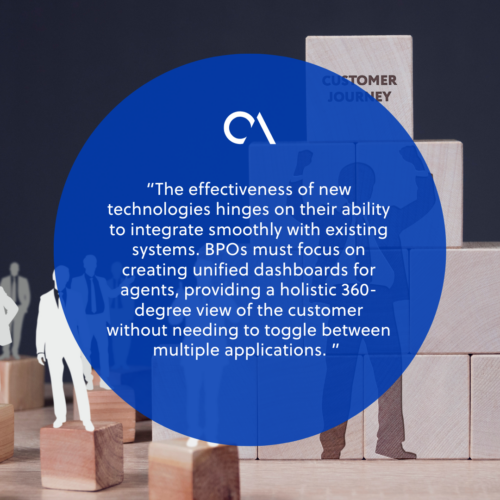Next-gen CX: How BPOs can redefine customer experience strategy through tech

The echoes of yesterday’s customer service are fading fast. Today’s customers demand instant gratification, hyper-personalization, and seamless interactions, defining the modern customer’s expectation.
Creating an exceptional customer experience strategy should be the goal.
For BPO providers, this is both a challenge and an opportunity. Their inherent expertise, scalability, and global reach uniquely position them to champion a new era of CX.
But despite all this, it’s worth looking through a practical lens. In the 540th episode of the Outsource Accelerator Podcast, James Reynolds from Peak Outsourcing shares how he approaches new CX developments.
According to James, “I’ve seen a lot of changes, and I think this is just the next natural evolution to how we’re leveraging technology in our world, particularly from a CX perspective, contact center operations point-of-view.”
This article will explore how BPOs can strategically harness new technologies and evolving developments to fundamentally redefine their customer experience strategy, ensuring they remain at the forefront of service innovation.
The shifting landscape of customer experience
Customer expectations have truly rocketed into the stratosphere. The days of waiting on hold for minutes, or even hours, are largely obsolete.
Today’s customers seek immediate responses, consistent interactions across every channel, be it phone, chat, email, or social media. Plus, a personalized touch that makes them feel understood.
Marigold found that 53% of US consumers rated excellent customer service and support as more important than price.
This isn’t just about speed; it’s about a holistic, intuitive journey. For traditional BPOs, this shift presented formidable challenges.
Yet, within these challenges lies immense potential for technology to serve as the ultimate CX enabler, transforming every facet of customer interaction.
From the inside, James notes that everyone is eager to apply new tools.
“Every aspect of every industry is looking for a way to be able to leverage this technology and capability. So everyone has a vested interest and desire to make this work.”
3 key technologies redefining customer experience strategy for BPOs
The rapid evolution of technology offers BPOs unprecedented tools to sculpt a superior customer experience strategy. By strategically adopting and integrating these innovations, BPOs can move beyond transactional support to become true CX innovators.
Artificial Intelligence (AI) and Machine Learning (ML)
AI and ML have become central to modern customer experience strategy. These technologies enable BPOs to automate routine inquiries, predict customer needs, and provide faster, more accurate responses.
For instance, AI-powered chatbots can handle high volumes of queries 24/7, reducing wait times and improving customer satisfaction.
ML algorithms can also analyze vast amounts of data to deliver personalized recommendations and predict customer behavior, transforming how BPOs interact with customers.
Omnichannel and unified communication platforms
The customer journey rarely sticks to a single channel anymore. Customers might start on chat, move to email, and then call—expecting a seamless transition.
Omnichannel platforms are critical, integrating all touchpoints (voice, chat, email, social media, SMS) into a single, unified view.

This ensures that regardless of the channel, customer history is immediately accessible to the agent. This enables personalized interactions and eliminates the frustration of repeating information.
For BPOs, this creates a cohesive customer experience strategy that mirrors modern customer behavior.
James explains that this is basic to providing good CX.
“From a CX perspective, I don’t know if our expectations around accuracy and quality have changed much. Things like being able to reach out through the channel that works best for you and being able to get a timely response in your first interaction.”
Cloud-based contact center solutions
Cloud-based platforms enable BPOs to deliver scalable and flexible customer experience solutions. Cloud contact centers, for example, provide agents with real-time access to customer data and enable remote work capabilities.
This flexibility enhances service continuity and allows BPOs to meet customer demands even during unexpected disruptions.
How BPOs can adapt their customer experience strategy
Embracing these technologies requires BPOs to strategically adjust their internal workings and overall customer experience strategy. This isn’t a one-off project but a continuous evolution.
1. Invest in upskilling and reskilling the workforce
The human element remains central, but agent roles are evolving. BPOs must invest heavily in training their workforce to work alongside AI tools, fostering “AI-augmented agents.”
This involves developing skills in data interpretation, complex problem-solving, and crucial human empathy, as AI handles routine tasks. Cultivating a continuous learning culture ensures agents remain agile and effective.
James says that nurturing your staff is key.
“With all of the technology, a lot of that responsibility at the end of the day comes back to a person sitting at the contact center. It’s very important to keep in mind how those people are treated.”
2. Adopt a data-driven CX strategy
Guesswork has no place in next-gen CX. BPOs must transition from reactive service to a proactive, data-driven approach.
By gathering comprehensive insights from every customer interaction, they can:
- Identify trends
- Pinpoint pain points
- Uncover opportunities for service improvement
This allows for personalized customer interactions and continuous optimization of processes based on measurable performance metrics.
3. Prioritize seamless technology integration
The effectiveness of new technologies hinges on their ability to integrate smoothly with existing systems. BPOs must focus on creating unified dashboards for agents, providing a holistic 360-degree view of the customer without needing to toggle between multiple applications.
Prioritizing user-friendly interfaces for agents minimizes friction, reduces training time, and directly translates into faster, more consistent customer service.

4. Strengthen cybersecurity and data privacy measures
As more sensitive customer data flows through digital channels and AI systems, cybersecurity and data privacy become non-negotiable. BPOs must implement robust security protocols, including encryption, multi-factor authentication, and regular security audits.
Ensuring strict compliance with global data protection regulations (like GDPR and HIPAA) is vital for building and maintaining customer trust. This is fundamental to any sound customer experience strategy.
James emphasizes this for Peak Outsourcing.
“Top of mind for us is to ensure that we’re respecting the security of our client’s data.”
5. Cultivate a culture of innovation and customer-centricity
Technology alone won’t redefine CX; it needs a supportive culture.
BPOs should foster an environment that encourages experimentation with new CX technologies and empowers agents to contribute ideas for service improvement.
Placing the customer at the heart of every technology decision ensures that innovation directly serves the goal of delivering an exceptional customer journey. Technology is transformed from a tool into a strategic enabler of customer delight.
Welcoming CX innovation
The journey towards next-gen CX is an exciting, albeit challenging, one for BPOs.
By strategically embracing and integrating cutting-edge technologies and by committing to continuous adaptation and human-centric innovation, BPOs are not just responding to market demands.
They are actively redefining their customer experience strategy, moving beyond traditional service delivery to offer more efficient, personalized, and impactful interactions.
James says that at the heart of it all, the best solution is the one that improves your customers’ service.
“As complicated as things can be or are getting, we still look for some sort of personal connection. How do we find ways to do things easier and better for our customers and clients?”
This commitment positions them as true industry leaders, poised to deliver unparalleled customer experiences in the rapidly evolving digital future, securing not just their own success, but that of their clients.







 Independent
Independent




